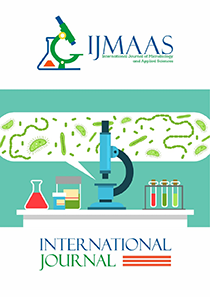Microbiological Assessment of Sun-Dried Beef (Tinko) Sold in Some Markets in Port-Harcourt Metropolis, Rivers State
Vol 3, Issue 1, 2024
KEYWORDS
Sun-dried beef, markets, microbiological monitoring, bacteria, fungi, food safety, public health
Abstract
The safety of sun-dried beef (Tinko) is critical for public health since it is a popular and commonly eaten food. This study investigated the bacterial and fungal contamination of dried beef samples towards evaluating the overall safety of this food product. A total of eighteen (18) dried beef samples were purchased from six major markets in Port Harcourt, Nigeria and transported immediately to NSPRI, Port-Harcourt for microbiological analysis. Identification of bacteria and fungi isolated from the samples was determined based on standard methods. Statistical analyses were performed using SPSS 20.0. Results showed that there was significant difference p < 0.05 in both bacteria and fungi counts with higher bacterial counts at 105cfu/g compared to fungi counts at 103cfu/g recorded. The bacterial counts of dried beef from Oil Mill (5.10±0.30 x 105cfu/g) and Rumuokoro (7.85±0.65 x 105cfu/g) markets were above the International Commission of Microbiological Specification for Food (ICMSF) maximum microbiological limit of 5 × 105cfu/g. Identified bacterial isolates were Staphylococcus aureus, Escherichia coli, Bacillus subtilis, Bacillus cereus, Micrococcus luteus, Streptococcus sp and Pseudomonas aeruginosa. Bacillus subtilis (22.32%) and E. coli (7.29%) were the highest and least occurring bacteria respectively with the highest frequency recorded in Rumuokoro market (35.75%) and the least from Creek Road market (5.47%). Similarly, identified fungal isolates were Mucor mucedo, Aspergillus niger, Penicillium notatum, Rhizopus stolonifer and Cladiosporium sp. Rhizopus stolonifer (30.51%) and Penicillium notatum (10.17%) were the highest and least occurring fungi respectively with the highest frequency recorded in Rumuokoro market (38.99%) and the least from in both Creek Road market and Mile 1 market (8.47%). The presence of these potential pathogens in the beef samples emphasizes the significance of routine quality control and microbiological monitoring in the Port-Harcourt dried beef supply chain as to protect food safety and public health.
Current: Vol. 4, Issue 1, 2025

Call for papers
The International Journal of Microbiology and Applied Sciences warmly welcome your valuable articles for publication.
